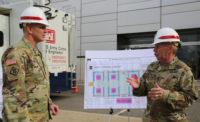Congressman Calls for ‘Natural Defense’ Policy To Spur Effective Land-Use Plans
While natural disasters may be inevitable, disastrous consequences are not, if policy-makers, designers and builders plan successfully. This theme was explored on May 12 at a one-day workshop in Washington, D.C., convened by the National Building Museum, which is laying the groundwork for a major exhibition in fall 2011 to examine how communities can improve planning to resist the consequences of natural disasters. Event planners looked for guidance from the museum’s Industry Council for the Built Environment, comprising about 60 owners and association representatives.

BLUMENAUR
“Disasters don’t have to be unmitigated disasters,” said U.S. Rep. Earl Blumenaur (D- Ore.), vice chairman of the Select Committee on Energy Independence and Global Warming and an active congressmen on national resiliency. The federal government could help improve the nation’s resiliency with “a natural defense policy” that creates disincentives for localities which fail to engage in effective land-use planning and building code enforcement, Blumenaur said. Further, it should incentivize individuals and communities that plan for mitigation and resilience. He suggested that, for example, utilities should be able to pass the cost of increasing system resiliency to ratepayers.
Blumenaur said the federal government should end programs encouraging the re-occupation of hazardous areas in post-disaster recovery situations. “The second or third time places burn in a fire zone, end the mortgage deduction. Send a message,” he said. “Putting people in harm’s way repeatedly ought not to be a way of life.”

RYND
The day’s second keynoter, U.S. Rep. Judy Biggert (R-Ill.), spoke of the need to reform, update and refund the National Flood Insurance Program—which she said is $18.75 billion in debt—or privatize it. She and other speakers emphasized the need to incentivize owners of existing homes and commercial buildings and infrastructure to retrofit for risk mitigation.
Mike Russell, senior counsel to the House Homeland Security Committee, said the eight-year-old Dept. of Homeland Security needs to be re-authorized. Started as a way to streamline the lines of responsibility in disaster preparedness and response, the department has fallen into a web of 108 congressional oversight committees and subcommittees. Russell also highlighted the need to fund, plan and build the infrastructure required to provide evacuation routes in future emergencies.
Attendees also discussed the idea of creating a common risk-assessment methodology for homes, facilities, neighborhoods and communities as well as the need to organize a multidisciplinary analysis of the risk exposure and possible mitigations available at a locale believed to be at a high risk for impending flood, fire, earthquake or another natural disaster.
Sara Yerkes, senior vice president of government relations at the International Code Council, said, “We need to call on industry groups to think more creatively about who we engage in this conversation.” Yerkes gave the examples of Catholic bishops, churches, synagogues and others who are engaged in helping families.
Chase Rynd, National Building Museum president, said the group actively will be seeking support as well as guidance for the exhibit. The council helps members engage candidly with elected officials and other policy-makers as well as offering each other advice. All this can occur, he said, because the museum is a “neutral forum—our sole agenda is intellectual development around the built environment that enables the museum to prosper.”








